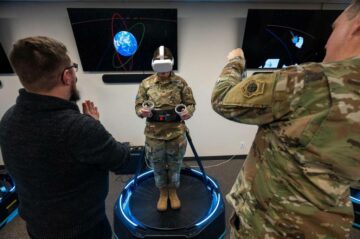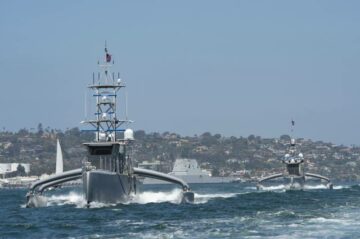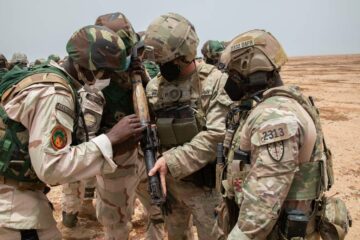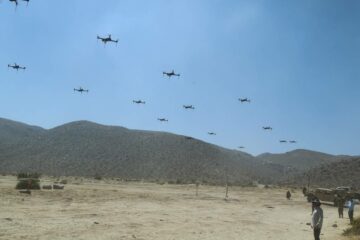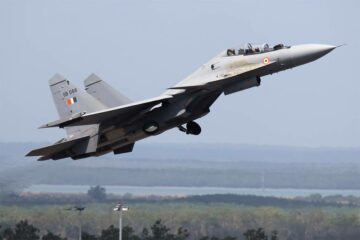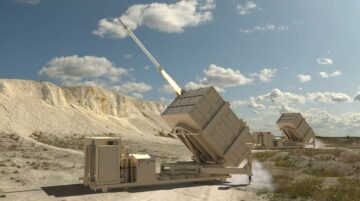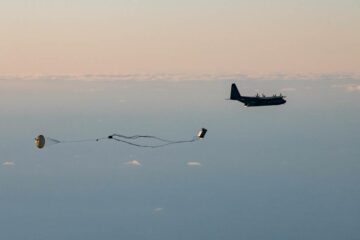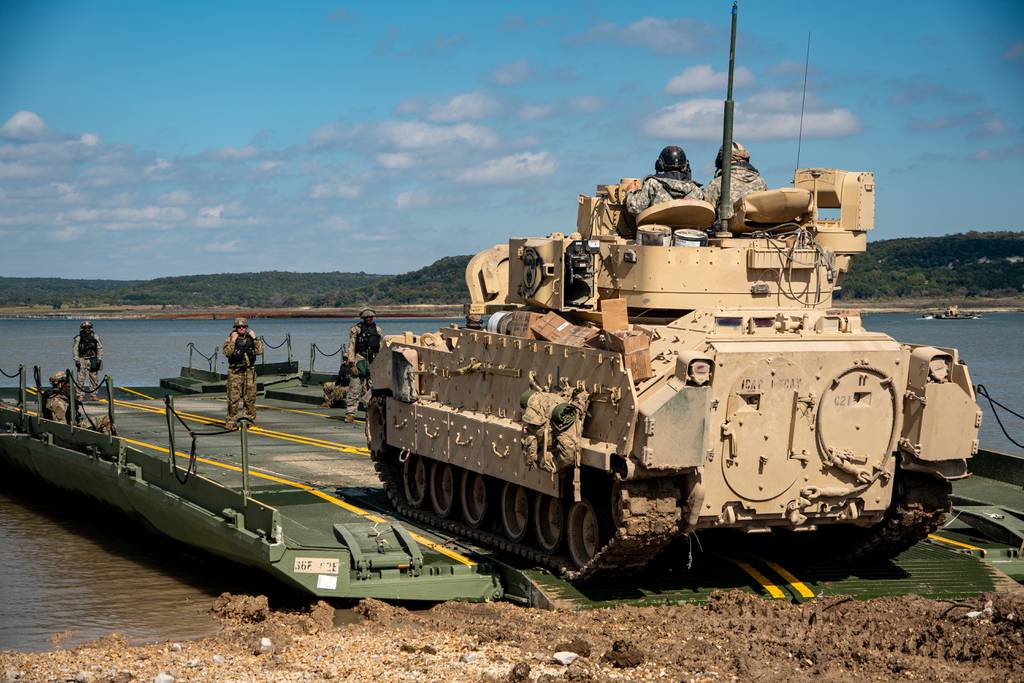
WASHINGTON — The U.S. Army successfully validated a force structure change meant to help it make better wet gap crossings during large scale combat operations, according to service leaders.
Defense experts have long considered U.S. bridging capability inadequate, particularly in the European theater.
Building bridges over rivers or other bodies of water to advance forward in an operation sounds simple, but involves complex coordination to ensure the enemy is suppressed long enough to move thousands of soldiers and equipment across and that the bridges can support even the heaviest combat vehicles and tanks.
And strong wet gap crossing capabilities are expected to be needed in the Indo-Pacific region, according to both Army officials and defense experts.
“The U.S. clearly does not have enough river crossing capability, and river crossing is an important part of what’s happening in Ukraine,” retired Army Lt. Gen. Ben Hodges, who previously led U.S. Army Europe, told Defense News in an interview earlier this year. Beyond Ukraine, bridging is “a capability that we need to have in a lot of places in the world.”
Typically, engineer brigades, which provide bridging capability, are a corps-level asset, but during a large-scale combat exercise — Remagen Ready — at Fort Cavazos, Texas, earlier this fall, the 36th Engineer Brigade was taken out of the III Armored Corps and brought into the 1st Cavalry Division, Maj. Gen. Kevin Admiral, 1st Cavalry Division commander, told Defense News in a Dec. 12 interview.
Corps are made up of two divisions and roughly 20,000 to 45,000 troops total, while divisions are made up of three brigades and 10,000 to 15,000 soldiers.
Wet gap crossings “is one of the most difficult things to do,” said Col. Aaron Cox, the 36th Engineer Brigade commander.
“We play one role, which is the actual building of rafts and full enclosure bridges. Those tactical challenges aren’t too difficult, but it is making sure that the fires threat is reduced, that there’s no enemy on the far side objectives, that we have obscuration, that the enemy’s logistics nodes on the far side have been suppressed,” he added. “That’s where the challenge comes from, and it’s converging all of those capabilities into one location in time so that we can successfully get across.”
Engineer units in divisions are “not purpose-built for large-scale combat operations,” Admiral noted. Those units are usually organized in battalions under brigade combat teams, which are not adequate to support large-scale combat maneuver. To conduct a wet gap crossing at the division level in large-scale combat, “I would need external resources that I don’t really have,” he said.
By putting the 36th Engineer Brigade into the 1st Cavalry Division for the exercise, it gave the division the assets and manpower it needed to execute the wet gap mission. Because the brigade was under the control of the division commander, it was easier to coordinate the complex movements needed to set the conditions for a safe crossing and then execute the crossing of about 20,000 soldiers and their armored equipment.
The 1st Cavalry coordinated the two-day live wet gap crossing during the exercise with two physical bridges using what’s known as the Improved Ribbon Bridge, made up of panels that can be put on the back of a truck for transport and then combined to make larger rafts. Seven panels connected together can support an M1 Abrams tank.
The exercise validated the need to put engineer brigades underneath division command, Admiral said, part of a larger plan to redesign force structure as the Army modernizes and shifts from years of using the brigade combat team as the tactical unit where maneuver operations are planned and executed. Now, the service plans to give the division that responsibility.
During the wars in Iraq and Afghanistan, BCTs operated relatively independently, but large-scale operations across land, air, sea, space and cyber against adversaries like Russia and China would require division-level operations.
The exercise “gave us a good chance to do an initial validation of the Army 2030 Armored Strike Division,” Admiral said. “This is the right direction for the armored divisions.”
Army Futures Command continues to work on what a modernized force’s structure will look like in 2030 and beyond, incorporating lessons from exercises like Remagen Ready.
The Army’s plan to grow its engineer companies, according to the service’s acquisition chief, Doug Bush, is “on track. It’s just finding the money,” he said in an interview this fall. “It’s a big priority, especially as they learned a lot from trying to move around Europe.”
Jen Judson is an award-winning journalist covering land warfare for Defense News. She has also worked for Politico and Inside Defense. She holds a Master of Science degree in journalism from Boston University and a Bachelor of Arts degree from Kenyon College.
- SEO Powered Content & PR Distribution. Get Amplified Today.
- PlatoData.Network Vertical Generative Ai. Empower Yourself. Access Here.
- PlatoAiStream. Web3 Intelligence. Knowledge Amplified. Access Here.
- PlatoESG. Carbon, CleanTech, Energy, Environment, Solar, Waste Management. Access Here.
- PlatoHealth. Biotech and Clinical Trials Intelligence. Access Here.
- Source: https://www.defensenews.com/land/2023/12/15/bridging-the-gap-army-validates-division-led-river-crossing/
- :has
- :is
- :not
- :where
- $UP
- 000
- 10
- 12
- 15%
- 1st
- 20
- 2030
- 70
- 8
- a
- Aaron
- According
- acquisition
- across
- actual
- added
- advance
- AFGHANISTAN
- against
- AIR
- All
- also
- an
- and
- ARE
- Army
- around
- Arts
- AS
- asset
- Assets
- At
- award-winning
- back
- BE
- because
- been
- ben
- Beyond
- Big
- bodies
- boston
- Boston University
- both
- BRIDGE
- bridges
- bridging
- brought
- Building
- but
- CAN
- capabilities
- capability
- challenge
- challenges
- Chance
- change
- chief
- China
- clearly
- College
- combat
- combined
- comes
- Companies
- complex
- conditions
- Conduct
- connected
- considered
- control
- converging
- coordinate
- coordinated
- coordination
- covering
- Cox
- crossing
- cyber
- Defense
- Degree
- difficult
- direction
- Division
- do
- does
- Dont
- doug
- during
- Earlier
- easier
- engineer
- enough
- ensure
- equipment
- especially
- Europe
- European
- Even
- execute
- executed
- Exercise
- exercises
- expected
- experts
- external
- Fall
- far
- finding
- fires
- For
- Force
- Fort
- Forward
- from
- full
- Futures
- gap
- gave
- Gen
- get
- Give
- good
- Grow
- Happening
- Have
- he
- help
- holds
- HTTPS
- i
- iii
- images
- important
- improved
- in
- incorporating
- independently
- initial
- inside
- Interview
- into
- involves
- iraq
- IT
- ITS
- journalism
- journalist
- jpg
- just
- known
- Land
- large
- large-scale
- larger
- leaders
- learned
- Led
- Lessons
- Level
- like
- live
- location
- logistics
- Long
- Look
- look like
- Lot
- made
- make
- Making
- master
- meant
- Mission
- money
- most
- move
- movements
- Need
- needed
- news
- no
- nodes
- noted
- now
- objectives
- of
- officials
- on
- ONE
- operated
- operation
- Operations
- or
- Organized
- Other
- out
- over
- panels
- part
- particularly
- physical
- Places
- plan
- planned
- plans
- plato
- Plato Data Intelligence
- PlatoData
- Play
- previously
- priority
- provide
- put
- Putting
- ready
- really
- redesign
- Reduced
- region
- relatively
- require
- Resources
- responsibility
- Ribbon
- right
- River
- rivers
- Role
- roughly
- Russia
- s
- safe
- Said
- Scale
- Science
- SEA
- service
- set
- seven
- she
- Shifts
- side
- Simple
- So
- Space
- strike
- strong
- structure
- Successfully
- support
- sure
- tactical
- taken
- tank
- Tanks
- team
- teams
- texas
- that
- The
- the world
- Theater
- their
- then
- they
- things
- this
- this year
- those
- thousands
- threat
- three
- time
- to
- together
- told
- too
- Total
- track
- transport
- truck
- trying
- two
- u.s.
- Ukraine
- under
- underneath
- unit
- units
- university
- us
- using
- usually
- validated
- validation
- Vehicles
- was
- Water
- we
- What
- which
- while
- WHO
- will
- with
- Work
- worked
- world
- would
- year
- years
- zephyrnet


